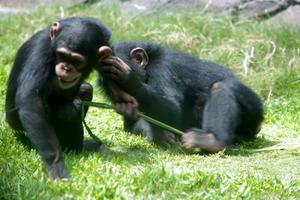Field scientists working in the Ebo forest of Cameroon, Central Africa recently made a groundbreaking discovery when they witnessed chimpanzees using stone hammers to crack open hard-shelled nuts to extract the edible interior. Although scientists have long known that all studied chimpanzee populations use various tools, there is significant cultural variation in tool-use, and this socially transmitted tradition of hammer use to crack nuts was previously believed to only exist in populations living west of the N'Zo-Sassandra river in Ivory Coast, hundreds of miles away from where it was recently observed.

This unique and unexpected behavior uncovered by Bethan J. Morgan, Ph.D., from the San Diego Zoo's center for Conservation and Research for Endangered Species (CRES), and her senior research assistant Ekwoge E. Abwe will be reported in the August 22 issue of the scientific journal Current Biology.
"This observation challenges the existing model of the cultural diffusion of nut-cracking behavior by implying that it has been invented on multiple occasions," explained Morgan. "Alternatively, if nut-cracking is an ancient trait in the western chimpanzee populations then there have been extinctions of the behavior in areas between the N'Zo-Sassandra River and the Ebo forest."
According to Morgan, this observation raises many interesting questions that deserve further research, such as why this behavior is absent in many wild populations that have access to crackable nut species and suitable tools. What is the rate of invention, and what causes extinction of learned behaviors within populations?
Morgan first presented the findings in late June at the International Primatological Society biannual conference in Uganda. According to Morgan, this subspecies of chimpanzee, Pan troglodytes vellerosu, is the most endangered and the least studied of all chimpanzee subspecies with an estimated total population of fewer than 6,500 remaining individuals. This is one of the first observations of tool use in this subspecies, and underlines the importance of research to gain an understanding of, and to preserve, the rich array of cultures found across chimpanzee populations and communities, which are our best model for understanding the evolution of hominid cultural diversity.
Chimpanzee populations are greatly threatened by the commercial bushmeat trade (the illegal hunting and trafficking of wild animals) throughout western Africa. This trade is considered by conservationists to be one of the most significant and immediate threats to the future of wildlife populations in Africa today, and could lead to the extinction of several species within the next couple of decades, including chimpanzees.
"We hope that this finding may help to establish a long-term research program to study this subspecies and provide what is, in many cases, the only effective conservation protection currently available for great apes in the region," said Morgan.
The not-for-profit Zoological Society of San Diego, dedicated to the conservation of endangered species and their habitats, engages in conservation and research work around the globe. The Zoological Society manages the 100-acre San Diego Zoo, the 1,800-acre San Diego Zoo's Wild Animal Park (more than half of which has been set aside as protected native species habitat) and the center for Conservation and Research for Endangered Species (CRES).




